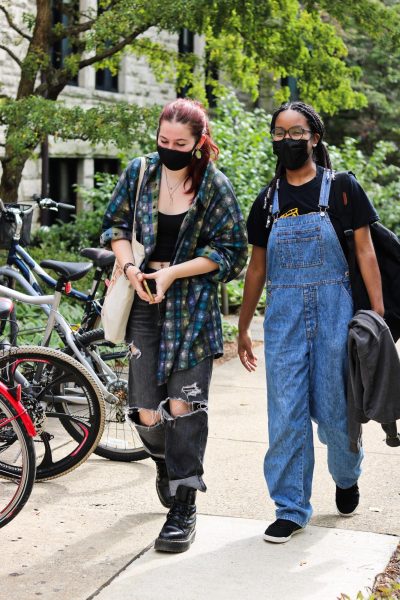Self-Diagnosis on Social Media Detrimental to Perceptions of Mental Health
As you scroll aimlessly through social media, a video pops up saying, “5 signs you have ADHD.” Quickly losing focus, losing track of time, mood swings, trouble listening, being extremely talkative, losing things easily, or being disorganized — every sign seems to point to you and what you have been struggling with. You might feel a sense of finally being understood and seen. Your struggle has this new name, and you feel like you’ve finally found the fix — the solution to what you’ve felt for so long. Your feelings finally belong somewhere.
Videos like these have flooded social media platforms. I bet you’ve seen a couple. Topics of discussion range anywhere from anxiety, personality, and mood disorders to disabilities like autism and ADHD. The videos typically consist of an explanation of the “signs” that someone might have a particular condition, but often these so-called “signs” consist of behaviors that anyone could experience. People take this information, relate to it, and start to believe they have the condition they’re hearing about. A troubling trend of people self-diagnosing seems to have taken off these past few years.
The COVID-19 pandemic took a toll on many people’s mental health. This shared experience opened up more discussions around mental health, especially on social media, and efforts to destigmatize mental health struggles have increased. According to a World Health Organization brief, there was a 25 percent increase in the global prevalence of anxiety and depression within the first year of the pandemic. As people were left alone, they began to notice things about themselves that were not obvious before. People were forced to look at their own behaviors, patterns, thoughts, and interactions with others in a way they had not before. As one of the only methods of communication available at the time, social media became a tool for people to feel seen and recognized. Mental health became a central focus, and since then, online mental health communities have been built to open up conversations for struggling people and offer a space for them to share their experiences.
The movement to destigmatize mental health was created to help those who have struggled alone with their mental illness feel seen. After centuries of mental illness being viewed as something that is “wrong” with someone, people are finally feeling accepted despite their struggles. It’s possible, however, that we have reached the point at which this phenomenon is causing more harm than good. There has been what almost seems to be a romanticization of mental illness — people have started to just throw delicate terms and diagnoses around as if they are character traits you can easily assign to yourself. The thing is that we aren’t dealing with simple character traits. We are dealing with intense human struggles that have been left in the dark for far too long.
There has been a drastic shift in how mental illnesses are being presented on social media. We’ve gone past sharing personal experiences to help build a human connection in which someone can feel less alone. Now, people have taken it upon themselves to act as professionals and offer easy answers to people’s complex questions about mental health and disability, with some even trying to provide diagnoses. A majority of the videos about mental illness you see on social media aren’t created by professional psychologists. There are some psychologists offering information about different mental illnesses online, but what they are offering is education on the subject, not a diagnosis. There is a very big difference between feeling anxious or depressed and being clinically diagnosed with anxiety or depression. As any psychologist would tell you, this distinction is very important, but in the world of social media, these lines have been blurred. It is possible that the de-stigmatization of mental illness has been hijacked by social media, and in turn, we’ve been lured into making those struggling with a clinical diagnosis feel unseen again — just in a different way.
You don’t need to have a clinical diagnosis or a severe mental health disorder to know that when you are in that amount of pain, you long to have the world tell you that you are seen. In the past, that need was crushed because you were met with the burden of a world saying, “Keep your mental illness hidden.” While it is true that in today’s society that voice has somewhat dissipated, what we need to understand is that we haven’t gone from “keep it hidden” to “I see you.” Instead, the source of feeling invisible has switched from feeling silenced to feeling minimized, as though one is in a crowd where everyone is chanting “welcome to the club.”
This is not to say that you aren’t in pain if you have felt anxious or depressed. We as humans experience those feelings, and they are very difficult to deal with. This is not about minimizing pain; it is about how social media tempts and invites us to express that pain in a way that equates it with a different type of pain, thereby minimizing the pain of those who consistently struggle with mental health disorders.
To all the college students reading this, we have an important role. As young adults who have grown up with social media, we sit in the eye of this great storm. We are discovering so much of ourselves amid great amounts of academic and social pressures. In one way or another, we are all dealing with our own important struggles, but we are tempted to misplace these struggles in order to feel seen. Social media has taught us to all strive for the spotlight, but this is not the world we want. As the ones most impacted by this phenomenon, we get to be on the frontline. We have the chance to reset our approach to one another’s struggles and help all of us feel seen without blurring the lines between self-diagnosis and clinical diagnosis to feel valid. We can create a world in which, instead of competing to be seen, we can be the ones assuring each other, “you are seen.”




